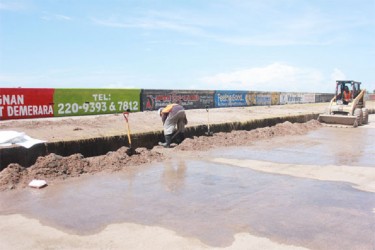The Civil Defence Commis-sion (CDC) yesterday held a half-day consultation on Guy-ana’s Early Warning Systems (EWS) as the country seeks to equip itself with the tools to ensure that citizens are informed and response mechanisms activated in times of natural disasters.
The consultation took place at the Carifesta Sports Complex, Carifesta Avenue and saw the participation of a number of stakeholders drawn from various government ministries and agencies.
The EWS, which is yet to be implemented, has among its architecture notification of citizens through social media, text messages, loud hailers, CD radios, signs, email, flyers, sirens and signs on buses in time of impending natural disaster.
The EWS protocol establishes a hierarchy where the ministries of Agriculture, Public Works and Health will pass messages to the Office of the President/Neighbourhood Democratic Councils/CDC. There will then be discussions with the President/Head of the Presidential Secretariat for approval of alerting and preparedness message. The message is then disseminated through Government Infor-mation Agency to media houses, government agencies, the Red Cross.
The draft document said that to address the gaps that exist in early warning technologies and capacities, it is recommended that there is development of national research, monitoring and assessment capacity, including monitoring of natural and man-made hazards; and education and awareness raising, including networking with universities with programmes of excellence in the field of emergency management.
Major Kester Craig, Operations and Training Officer of the CDC went through the draft plan and gave an overview of the state of disaster preparedness in Guyana. He said there is no formal EWS agreed to and no formal policy for its application in Guyana and hence the draft plan. “People are doing things that are helping in the process yes… but there are no formal roles and responsibilities that have been established,” he said.
Craig said decision-making processes at the technical level are not formalised or coordinated. He said that while the technical people know what they have to do, it is done in a haphazard manner.

He said while policy makers will make decisions about disaster management, these are not streamlined and dissemination is currently limited.
He said that it makes no sense to have an EWS and not have the mechanism to respond to a particular hazard.
Early warning has to do with getting information to people so that they can take steps to reduce the impact. “We need to look at how we could mitigate our losses through prevention and also mitigation and to complement EWS we need to have the technology,” he said.
“You must have timely and effective information and it involves the different institutions which must take action to avert the risks and prepare effectively for the response,” he said. “This definition is an internationally recognised one taken from the International Strategy for Disaster Reduction by the United Nation in 2006.”
He said that EWS is necessary to protect lives and livelihood from hazards which have economic, environmental and social impacts. “So once you have an EWS in place, you are going to reduce the impacts that are going to be caused by those hazards,” he said.
“We are all aware of flooding due to excessive rainfall, as a result of overtopping of the sea wall and there is also drought because of insufficient rain over an extended period…there is also high winds affecting persons along the coast and there is risk of wild fires and urban fires.”
He pointed out also that there is also the risk of health hazards, noting that the CDC recently responded to the outbreak of gastroenteritis in Region 1.
It is expected that the CDC will continue its series of consultations on the EWS with a view of ensuring persons become familiar with it prior to it becoming formalised.





